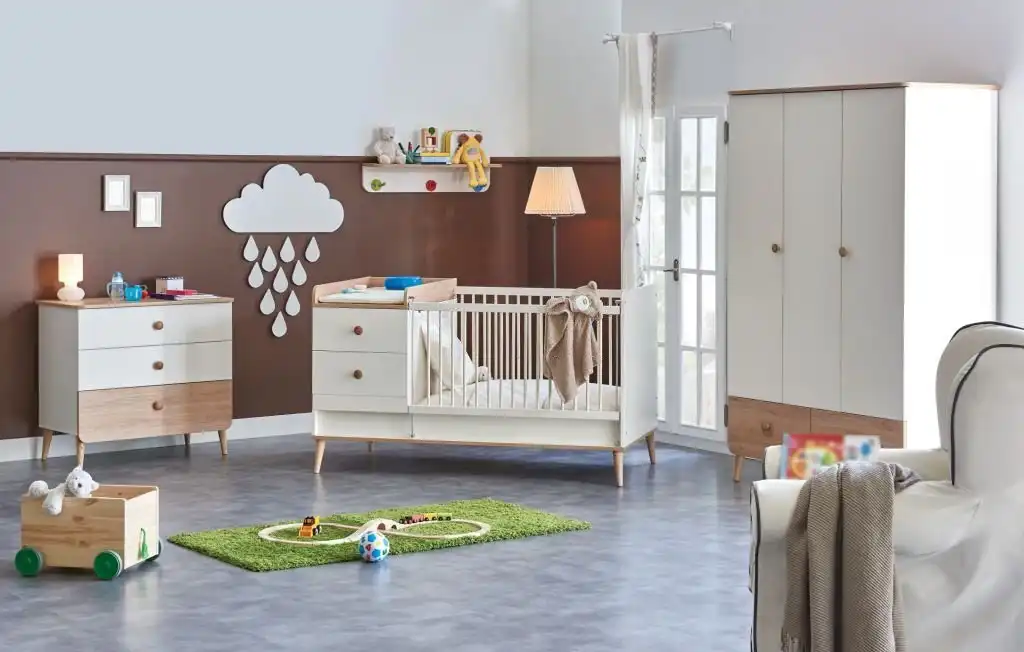Let There Be Light: Pros and Cons of Nursery Floor Lamps for Your Baby’s Room

When planning nursery decor, many people consider adding a floor lamp. However, there are potential hazards to be aware of when having such a lamp near a baby or toddler. While these lamps can bring visual appeal, it is essential to consider the potential risks associated with floor lamps before purchasing.
Should you put a floor lamp in the nursery?
Choosing the right lighting for your nursery is essential to achieve a tranquil, calming atmosphere and accommodate practical needs.
Floor lamps are one solution when overhead lighting isn’t available and provide the perfect low-level illumination in the evenings; however, when the baby becomes more mobile and crawls around, there exist safety hazards associated with floor lamps, such as electric shocks or toppling over.
To prevent this type of danger without sacrificing adequate lighting in the nursery, consider installing overhead lights with dimmers or opting for a table lamp instead. With these easy adjustments, you can ensure your nursery is safe and pleasant.
Let’s look at some pros, cons, and alternatives to floor lamps in the nursery.

Pros of a floor lamp in the nursery
When outfitting a nursery, floor lamps can offer a variety of benefits. Bright lighting is essential for creating an inviting and safe space while illuminating any bedtime stories shared in the area.
Floor lamps are also generally easy to move around, so they can be adjusted as necessary or brought into another room. Finally, these lighting solutions offer elegant style options for any nursery design.
Floor lamps won’t shine in your baby’s eyes.
When lighting a baby’s nursery, overhead lighting can be too direct and intense. For optimal night-time and sleep settings, a lamp is much more appropriate.
The soft glow of a lamp can provide soothing illumination for your children without affecting their still-developing eyes negatively or overstimulating them. Opt for placing the lamp in the corner of the room for easy access and a comfortable ambiance.
Floor lamps are affordable.
For a low-cost lighting option, consider a floor lamp. Online retail giants such as Amazon offer many models to choose from. For an additional customizable touch, visit your local garage sale or thrift store and find some vintage gems. Depending on the level of detail and quality you desire, floor lamps could be acquired for as low as an estimated $20-30.
Floor lamps are easy to install.
Installing ceiling lights can be expensive if you don’t already have any.
If you’ve never worked with wiring, installing a new ceiling fan or overhead lighting fixture with existing electrical might require much effort.
All you need to do with a floor lamp is plug it in and get started.
Since most floor lights don’t need to be assembled, it doesn’t matter if you can’t use a screwdriver.
The floor lamps look pretty.
Online retailers provide lovely nursery floor lamps.
You may choose a lamp to match any nursery décor, whether you prefer a simple, modern lamp, a traditional carved wooden floor lamp, or even a giraffe-shaped lamp.
Cons of a floor lamp in the nursery
The negative effects of having a floor lamp in your baby’s room will now be discussed.
Floor lamps can be knocked over.
Parents are concerned that their infant or young child will pull or knock the floor lamp over.
This can be quite risky, especially if an adult isn’t there.
A child could be hurt by the weight of the lamp and the bulb breaking and sending glass fragments flying across the room.
If the bulb isn’t broken by the fall, your baby risks severe burns if they handle it.
When the infant is a newborn, this won’t be a large problem, but as soon as the baby begins to crawl, a floor light becomes a serious hazard.
Floor lamps have power cords.
The fact that floor lamps must be hooked into power outlets, which are typically below the floor, is another problem.
Baby exploration of power lines, outlets, and switches can be alluring.
Even though fatalities from childhood electrocution are uncommon, if your kid were to pull the plug and get their fingers in the socket, they could receive a very unpleasant jolt.
Floor lamps don’t fit in every nursery.
Many nurseries lack enough space for a floor light because they are frequently the smallest bedrooms in the house.
A floor light might not fit in the corner of the room if your baby’s nursery is in a converted attic or a room with sloping walls.
Ways to make floor lamps safer for the nursery
Despite the potential danger of floor lights, there are numerous things you can take to reduce your child’s risk of injury.
Position the lamp behind the furniture.
The negative effects of having a floor lamp in your baby’s room will now be discussed.
Loop a string around the lamp and tie it to a wall-mounted hook.
Although it isn’t the nicest fix for the floor lamp safety problem, it is straightforward and effective.
All you need is a screw-in or self-adhesive wall hook and some twine. T
This will make it impossible for your kid to knock the lamp over.
Glue the lamp to the floor.
Parents do this; it’s true!
If your floors are firm, you might anchor the lamp’s base to the floor with super-strong glue-like “No More Nails.”
Of course, if you have carpet, this won’t work.
When you move home, remember that this substance is practically impossible to remove, so the lamp might have to stay behind!
Choose a floor lamp with a wide, heavy base.
Some floor lamps are made less dangerous to use around children and animals.
These are often heavy and wide and have broad bases that make it challenging to stop them.
Try this out for yourself rather than depending on the manufacturer’s promises because the heavier a light is, the more damage it could do if it were to be pulled over.
Here, the cost is frequently important. More expensive lamps frequently have more weight holding them down, but cheaper lamps are flimsier and simpler to tumble.
Hide the power cord.
Power wires can be concealed in various ways to keep children away.
Rubber cable covers may not be the most attractive option, but they help stop curious children from grabbing at cords.
A box outlet cover is something else you should search for.
You can still plug the lamp in when the power socket is covered.
Choose a cordless floor lamp.
There are cordless floor lamps that run on batteries.
Although they are less common than typical corded floor lights, they can be a wonderful option if you are concerned about power cords trailing or don’t have an electrical outlet nearby.
Alternatives to nursery floor lamps
They are a common choice for parents who want to provide a soft, soothing light source for their little ones. However, several alternative nursery floor lamps can serve the same purpose while adding a touch of uniqueness and style to the nursery.
Wall Sconces
Wall sconces are a great alternative to nursery floor lamps. They provide soft, diffused lighting in various styles to match any nursery decor. Wall sconces are also a great way to save space in the nursery, as they can be mounted directly on the wall.
Table Lamps
Table lamps are another great option for nursery lighting. They come in various shapes and sizes and can be placed on a dresser or nightstand to provide a soft, warm glow. Table lamps are also easy to move around and can be used in other areas of the house.
Pendant Lights
Pendant lights can add a unique and modern touch to a nursery. They hang from the ceiling and provide a soft, diffused light source. Pendant lights are available in various shapes and styles, making it easy to find one that matches the nursery’s decor.
String Lights
String lights can add a whimsical touch to a nursery. They come in various shapes and sizes and can be hung from the ceiling or draped over furniture. String lights are also a great way to create a cozy and inviting atmosphere in the nursery.
Night Lights
Night lights are a great option for parents who want to provide a soft, gentle light source that won’t disturb their little one’s sleep. Night lights are available in various shapes and sizes, from traditional plug-in models to battery-operated options that can be placed anywhere in the nursery.
Verdict
In conclusion, whether or not to put a floor lamp in the nursery is a personal decision that depends on several factors, including safety concerns, space limitations, and the desired lighting effect.
While nursery floor lamps can provide a soft and soothing light source, they may not be the best choice for all parents. It’s important to weigh the pros and cons before making a decision and to choose a lighting option that is safe, functional, and aesthetically pleasing.
Also Read: The 8 Best Floor Lamps For Nurseries — To Ensure The Best Sleep For Baby
FAQs
What are floor lamps used for?
Floor lamps are a type of lighting fixture designed to be placed on the floor and provide a light source in a room. Here are some common uses of floor lamps:
General lighting
Floor lamps can be used as a room’s general lighting source. They provide a soft and diffused light that can help to create a warm and inviting atmosphere.
Task lighting
Floor lamps can also be used for task lighting, such as reading or working on a project. They can be positioned next to a chair or desk to provide a focused light beam.
Accent lighting
Floor lamps can highlight a specific area or object in a room, such as a piece of artwork or a plant. Depending on the desired effect, they can be positioned to shine light upward or downward.
Decorative lighting
Floor lamps can be used as a decorative element in a room. They come in various styles and designs, from modern and minimalist to traditional and ornate, and can help complement the overall decor of a space.
Ambient lighting
Floor lamps can provide ambient lighting in a room, creating a soft and inviting glow that can help set the mood for a cozy and relaxing evening at home.
In summary, floor lamps are versatile and functional lighting options that can be used for various purposes in a room, from general lighting to highlighting specific areas and objects. They can also be decorative, adding style and personality to any space.
What are the benefits of lamps?
On the nightstand in the bedroom, a table lamp is usual.
Incredibly convenient to turn on.
The bulb only casts light on a certain area.
It is ideal if you don’t want to wake up the person beside you.
The table lamp with a modest lightbulb is ideal to leave on throughout the night.
It is the ideal decorative component.
